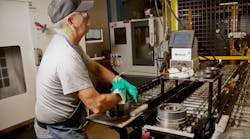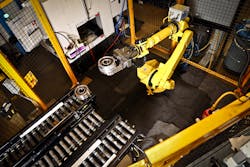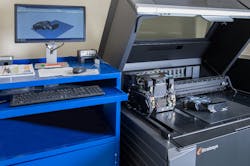ROSEVILLE, MN. Horton, a creator of fan drives, fans and suspension products for on- and off-highway vehicles and equipment, is continuing to find innovative ways to cool engines and manufacture its products.
"We do one thing really," said Horton CEO Cordell Dietz. "Of course we make fan drives and engine cooling solutions. But what we do is innovate… That's what the company was founded on was innovation. And that's the only reason we exist."
Horton recently hosted the media at its corporate headquarters here in Minnesota before flying reporters to its manufacturing facility in Britton, SD, to show how it innovates and engineers and manufactures its products, which are used in heavy- and medium-duty equipment worldwide. The cooling systems are offered by OEMs and sold by Horton as replacement kits.
The company has development and support centers in South Dakota, Indiana and Germany and offices on five continents. The factories use a mix of humans and automation to produce the engine cooling systems. The Britton, SD, facility is bright and quiet enough that workers don't need to use earplugs as they work with robots to build the Horton products.
When asked about need for cooling systems in electric-powered vehicles, Dietz was coy but said the company is taking that new power technology seriously. "We have active projects around that. You have be open-eyed and open-minded about what the future holds. If it goes that way, we're going to lead it."
"We're a focused company," Dietz said. "We do one general thing very, very well… You won't see Horton getting distracted by technologies and other areas and try to be a shop that does so many different things that we're not great at one thing. We want to be great at one thing."
That "one thing," Dietz said, extends into a lot of different marketplaces and the company has a vision for its next 30 years of growth. While he did not want to publicly expand upon where the company plans to go in the next three decades, Horton did tease some new products that will officially be released this September in Germany.
New products
Horton is introducing the HS6 and HS11A fans to help the on-highway market meet increasing efficiency demands on cooling systems by optimizing fan blade design characteristics. It also teased a new LCX Series of variable-speed fan drives to help medium- and heavy-duty truck OEMs meet increasingly stringent Green House Gas Phase 2 emissions regulations.
The new Horton HS6 features a six-blade design that is lightweight and efficient. The smaller number of blades reduces the amount of obstruction (reduced frontal area), allowing more ram air to pass through the compartment, according to company engineers. This “natural cooling” reduces draw on the engine, reducing fuel consumption and related emissions. When increased cooling is required, the design of the blade makes it fully capable of effectively and efficiently cooling the engine. The HS6 features 35-percent less blade area than the Horton 8-blade MS8 fan and its performance is enhanced when paired with a Horton fully-variable drive.
The Horton HS11A fan, with its blade profile, provides the increased flow and pressure required by the cooling systems in high-performance, heavy-duty trucks. It was designed for tightly packed airflow restrictive cooling systems. Though it features less blade area (5%) than the standard 11-blade molded fan, it produces 5% more airflow and two less decibels of noise.
“The HS6 and HS11A fans were designed to alleviate some of the challenges our customers are facing in achieving increased airflow with higher system restrictions,” said Manish Virmani, vice president of global market development at Horton. “They exemplify Horton’s ability to develop new and innovative products that allow truck manufacturers to meet increasingly stringent energy efficiency and sound regulations.”
The LCX Series is based on Horton’s variable-speed design which rotates the fan at a wider range of speeds to more precisely match actual cooling requirements. In effect, it does not merely run at ‘high’ speed as in the case of an on/off clutch, nor does it switch between a constant or high speed as in the case of a two-speed fan drive. The primary benefits, consequently, include reduced fuel consumption (and thereby emissions), decreased noise and less parasitic draw on the engine. The LCX Series enhances these benefits more with three industry-leading features: Cold-Start Disengagement (CSD), extremely low off-speed and superior low-speed controllability.
Variable-speed fan drives engage immediately upon startup and can remain engaged for some period, creating noise, reducing fuel efficiency and affecting engine reliability especially in cold weather conditions. Cold-Start Disengagement, however, is a proprietary, best-in-class technology, that disengages the LCX Series Fan Drives as much as 80% quicker than the closest competitor. This attribute allows engines and cabs to warm-up faster during cold weather starts. It also removes the burden from the engine, saving fuel and reducing associated emissions and noise.
Low off-speed in a fan drive ensures that minimal amounts of energy is consumed by the spinning of the fan during times when cooling is not needed. The new LCX Series drives feature industry-leading off-speeds that are as much as 50% lower than competitive products under similar conditions.
Optimized low-speed controllability is another feature built into Horton’s new LCX Series. Fan drives are often not fully capable of delivering precisely what an engine’s ECM requests concerning cooling production — especially when the engine speed is low and the desired fan rotation is also close to the lowest level.
This phenomenon is particularly noticeable on stationary equipment and manifests itself in the form of uncontrolled surges, wherein the system is relatively less stable. The LCX Series Variable-Speed Fan Drives can be controlled at very low speeds to accommodate slighter cooling needs such as those associated with AC head pressure. The benefit, according to Horton, is more precise fan control across all speeds which increases fuel economy and thereby reduces emissions. Low-speed controllability also offers more available horsepower and decreased noise variation due to smoother modulation.
“These new best-in-class products provide Horton with a meaningful competitive advantage in the market and continue its tradition of innovation,” Virmani said. “Further, they will help our customers meet the escalating requirements and challenges presented by the EPA Green House Gas Phase 2 emissions standards for medium- and heavy-duty vehicles.”
Horton will officially launch the LCX Fan Drive Series and the HS6 and HS11A at the IAA in Hanover, Germany, which takes place Sept. 20-27.







